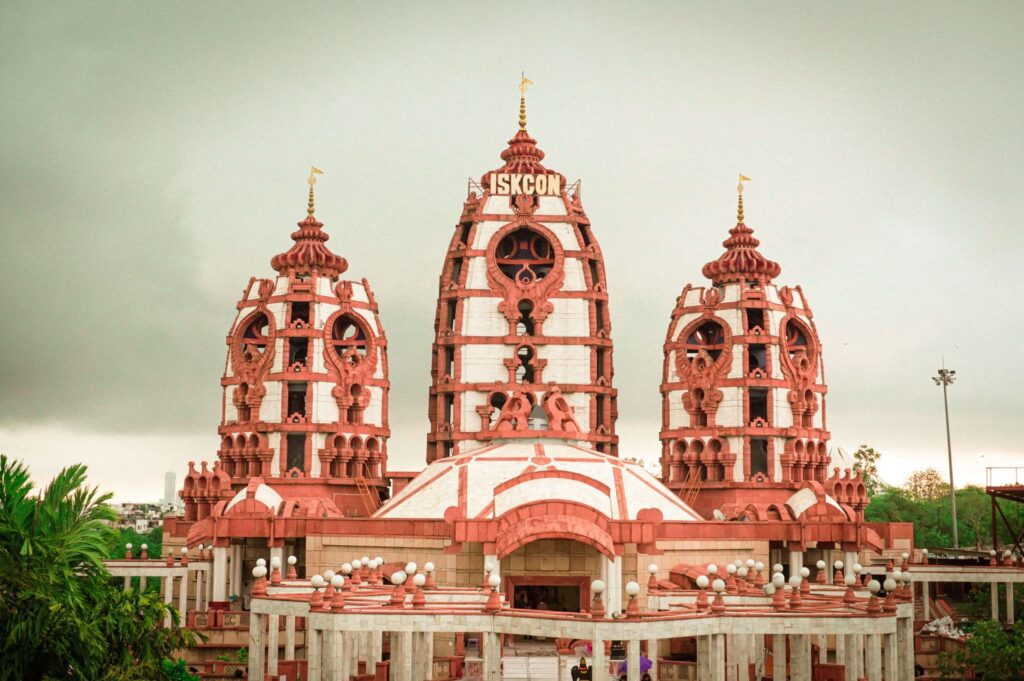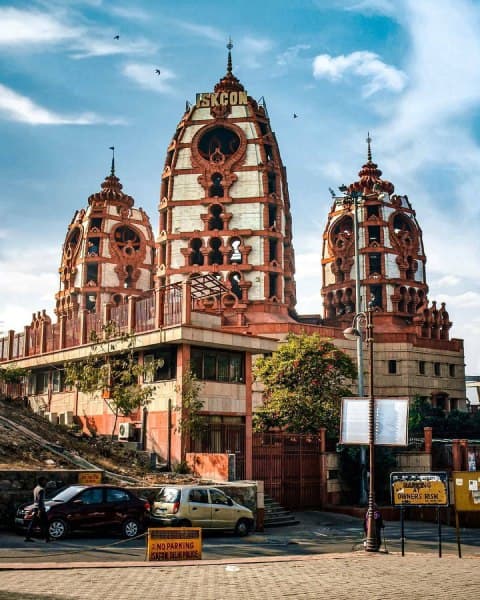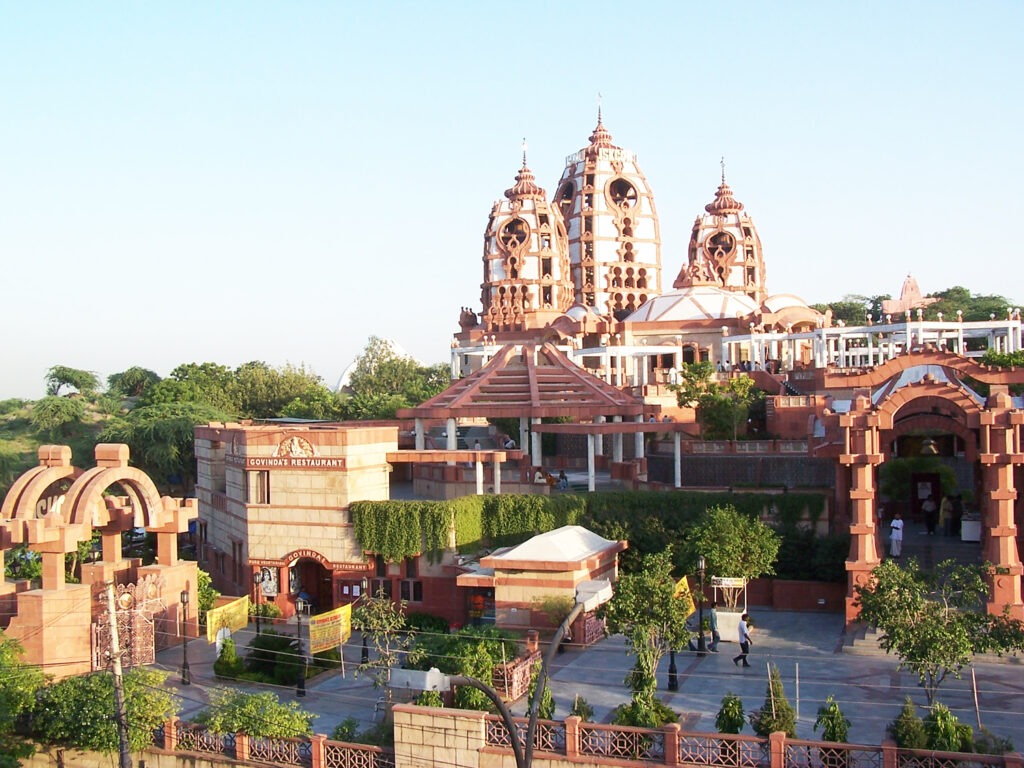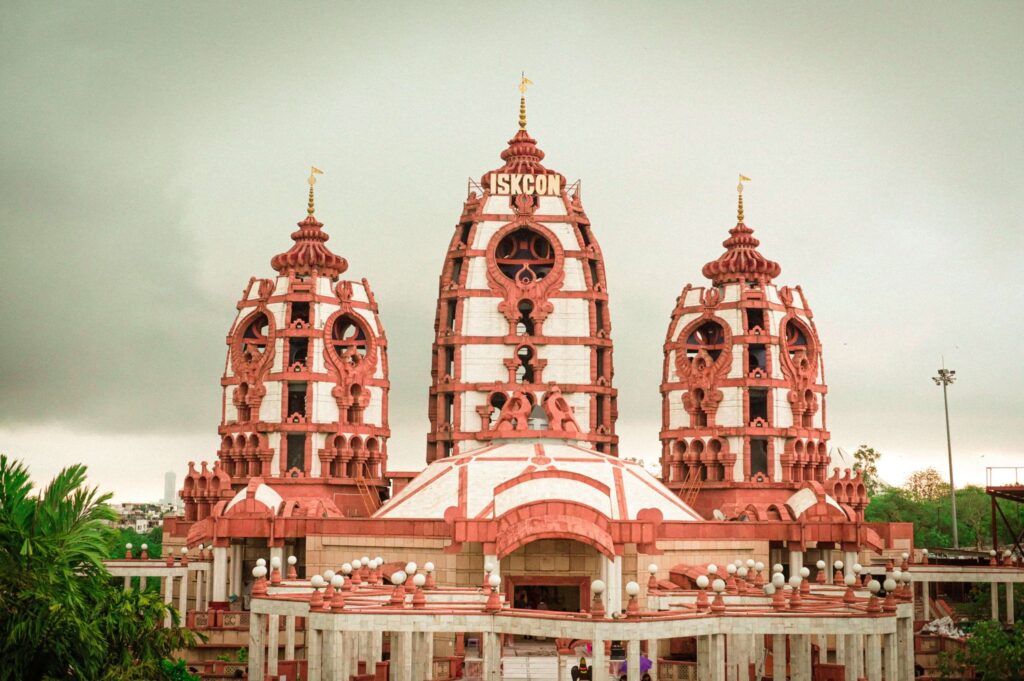In the heart of the bustling metropolis of Delhi, where the cacophony of daily life blends seamlessly with the spiritual yearnings of millions, stands the resplendent ISKCON Temple Delhi. Also known as Sri Sri Radha Parthasarathi Mandir, this magnificent temple is a sanctuary of peace and devotion, dedicated to Lord Krishna and Radharani. With its rich history, awe-inspiring architecture, vibrant cultural attractions, and profound spiritual significance, ISKCON Temple Delhi is not just a place of worship but an embodiment of divinity and enlightenment.

History and Foundation
The story of ISKCON Temple Delhi is intricately woven into the tapestry of the International Society for Krishna Consciousness (ISKCON). Founded by the illustrious A.C. Bhaktivedanta Swami Prabhupada in July 1966 in New York City, ISKCON rapidly gained followers worldwide. With its roots firmly established in the Gaudiya-Vaishnava denomination of Hinduism, ISKCON’s philosophy is centered on the worship of Lord Krishna, as inspired by the Bhagavad Gita.
However, it was not until the 5th of April in 1998 that the grand ISKCON Temple Delhi opened its doors to devotees and visitors. This architectural marvel was designed and brought to life by Padma Shri Achyut Purushottam Kanvinde, an architect renowned for his contributions to the field. Despite the initial target date of December 1995, the temple’s construction, funded primarily by donations from devotees across India and beyond, persevered to create a spiritual haven that would leave a lasting impression on all who visit.
Architecture and Design
The architectural beauty of ISKCON Temple Delhi harmoniously combines the traditional elements of Hindu temple design with modern architectural principles. Perched atop Hare Krishna Hill, the temple towers boast latticed walls, which are a testament to the skill of the artisans who brought this vision to life. The materials used in the temple’s construction are as divine as their purpose – marble, wood, and meticulously carved stone merge to create a celestial ambiance.
Temple Complex
- The Main Temple: The heart of ISKCON Temple Delhi is the main temple, where devotees gather for daily rituals and arts. The deities of Lord Krishna and Radharani are enshrined here, receiving offerings of devotion throughout the day.
- The Centre for Vedic Studies: This section hosts seminars, classes, and conferences on Vedic philosophy, fostering spiritual learning and exploration. The Library of Vedic Research boasts a treasure trove of books in multiple languages, enabling visitors to delve into the wisdom of the Vedas.
- The Centre for Vedic Performing Arts: An open-air amphitheater welcomes traditional musical and dance performances, enriching the cultural experience of temple visitors.
- The Museum of Vedic Culture: An immersive journey into Hindu scriptures, this museum utilizes multimedia technologies to present ancient texts in a contemporary and engaging manner. The Bhagavad Gita Animatronics, the Mahabharata Experience, the Ramayana Art Gallery, and the Bhagavat Puran Exhibit provide a multifaceted understanding of Vedic culture.
- Krishna Jayanti Park: Inspired by Krishna’s early days, this park evokes the charm of Krishna’s playful interactions with milkmaids in idyllic gardens and groves. Ponds and waterfalls add to the tranquility.
- The Ashram: A residential complex within the temple premises, the ashram offers a space for Krishna devotees to focus on studying and teaching Vedic literature and lifestyle.
Worship and Rituals
The spiritual rhythm of ISKCON Temple Delhi unfolds through a meticulously organized schedule of rituals and ceremonies. The temple gates open with the Mangala Arati at 4:30 AM, a predawn ritual that ushers in the divine presence. Throughout the day, devotees and visitors can participate in various aratis, including Darshan Arati, Guru Puja, Raj Bhog Arati, Usthapana Arati, Sandhya Arati, and Sayana Arati, each providing an opportunity to connect with the divine.
Japa (Mantra) Meditation at 5:15 AM resonates with the repetitive chanting of verses from the Srimad Bhagavat Purana, considered a sacred text in Hinduism. Daily discourses on Srimad Bhagavatam at 8 AM and 8 PM offer spiritual insights and teachings to the eager minds of devotees and seekers.
Cultural Attractions
ISKCON Temple Delhi extends its spiritual narrative through captivating cultural attractions:
- Bhagavad Gita Animatronics: A mesmerizing blend of narration, drama, laser effects, and projections, this attraction vividly presents the five major concepts of Bhagavad Gita, Yoga, and the three modes of nature.
- Mahabharata Experience: A light and sound show that narrates the epic Mahabharata’s story, drawing visitors into the timeless saga of dharma and duty.
- Ramayana Art Gallery: A collection of oil paintings by ISKCON members from around the world, depicting the central characters of the Hindu epic Ramayana.
- Bhagavat Puran Exhibit: An engaging visual presentation that delves into Vaishnava customs and rituals.
- India’s Only Quadrascope: An immersive animated video on Vedic teachings projected on a larger-than-life video globe, transporting visitors into the depths of ancient wisdom.
Dining Experience
At ISKCON Temple Delhi, dining is not just a mundane activity but a spiritual offering to Lord Krishna. The temple boasts Govinda’s restaurant, renowned for its pure vegetarian and sattvik meals. Sattvik food aligns with the principles of Ayurveda and yoga, emphasizing a diet that is not just vegetarian but also free from onion and garlic, as they are considered to stimulate passion and are believed to hinder spiritual progress.
Govinda’s Restaurant: This eatery serves meals that are first offered to the deity of Krishna before being served to visitors. The process involves deep reverence and a belief in sanctifying the food through devotion. The concept of “prasadam” prevails, where the food is not just a meal but a blessing from the divine. The restaurant serves a total of 18 items each for lunch and dinner, ensuring a diverse and satisfying culinary experience.
Lunch and Dinner Timings: Lunch at Govinda’s begins at noon and extends until 3:30 PM, allowing ample time for devotees and visitors to partake in a wholesome meal. For those seeking a delightful dinner experience, the restaurant opens from 7 PM to 10 PM, ensuring that devotees can conclude their day with a spiritually nourishing meal.
Spiritual Philosophy
At the core of ISKCON’s spiritual philosophy lies the monotheistic devotion to Lord Krishna, as derived from the Bhagavad Gita. Despite Hinduism’s polytheistic nature, Gaudiya-Vaishnavism reveres Krishna as the supreme deity. The Bhagavad Gita, written in Sanskrit centuries ago, serves as the guiding scripture for ISKCON’s followers, emphasizing the importance of devotion, self-realization, and the eternal soul.
Festivals and Celebrations
ISKCON Temple Delhi is not merely a place of worship but a vibrant hub of festive celebrations. The temple comes alive during major festivals:
- Janmashtami: A grand 12-day celebration marks the birth of Lord Krishna, culminating in a majestic procession known as the Shobha Yatra.
- Ramanavami: The birthday of Lord Rama is observed with devotion and drama performances, allowing devotees to immerse themselves in the epic tale of the Ramayana.
Jagannath Rath Yatra: A hand-drawn cart parade and the ritualistic chappan bhog offering of 56 food items to the deity take center stage during this annual event in October or November.
Community Engagement
Beyond the realm of spirituality, ISKCON Temple Delhi actively engages with the community. Its outreach programs, charity initiatives, and educational activities are a testament to its commitment to the welfare of society. The temple opens its doors to individuals of all backgrounds, transcending religious boundaries and welcoming everyone on a spiritual journey.
Visitor Experience
Entering ISKCON Temple Delhi is akin to stepping into a realm of divine grace. As you approach the temple complex, the melodious chants of “Hare Rama Hare Krishna” create an ethereal ambiance. The aromatic incense wafts through the air, and the intricate temple architecture stands as a testament to human devotion. Each visit is a sensory journey, a chance to witness and absorb the profound spiritual energy that permeates the space.
The temple’s interior, adorned with ornate decorations and the divine presence of Lord Krishna and Radharani, evokes feelings of reverence and tranquility. As you partake in the aratis and rituals, you become part of a centuries-old tradition of devotion and self-realization.
Visitors are encouraged to explore the Bhaktivedanta Library, home to the largest printed version of the Bhagavad Gita in the world. This treasure trove of knowledge houses over 2,000 books, including spiritual texts, multimedia videos, and documentaries, offering a holistic learning experience.
ISKCON Temple Delhi Photos/Images






Nearby Attractions
For travelers seeking to extend their spiritual journey, ISKCON Temple Delhi serves as a gateway to several nearby attractions:
- Lotus Temple: A little over a kilometer away, the Lotus Temple, or Bahá’í House of Worship, entices with its lotus-shaped architecture and serene ambiance.
- Astha Kunj Park: A 10-minute walk from the temple, this park features a seasonal lake, an open-air gym, and bird-watching opportunities.
- Shri Kalka Ji Temple: 15 minutes from ISKCON, this 18th-century shrine dedicated to Goddess Kali fulfills the wishes of devotees.
- Ashokan Edict: Half a kilometer from the temple, Ashoka’s ancient rock edict sheds light on Buddhist teachings and the emperor’s transformation.
- Durga Bari Mandir: A 10-minute drive away, this temple dedicated to Goddess Durga hosts evening aratis and serves ritualistic bhog during Durga Puja.
- Hauz Khas Forest: Located 5 km away, this forest offers scenic beauty and a glimpse of the ruins of Siri Fort.
- Doctor Zakir Hussain Museum: Just 4 km from ISKCON, this museum showcases the life and contributions of the 3rd President of India, Dr. Zakir Hussain.
- Moth ki Masjid: This well-preserved 16th-century mosque, situated 6 km from the temple, features intricate Mughal architecture.
- Kale Khan Ka Makbara: About 6 km from ISKCON, this mausoleum, also known as Kale Khan ka Gumbad, contains the tomb of Mubarak Khan and offers a serene atmosphere.
How to Reach
Reaching ISKCON Temple Delhi is convenient, thanks to its accessible location:
- Via Metro: The Violet Line of Delhi Metro connects to the Nehru Place Station, just a few minutes walk from the temple.
- City Buses: The Mahalakshmi Layout Entrance bus stop is 2 km from the temple, while Hazrat Nizamuddin Railway Station, the closest railway station, is 4.5 km away.
- From the Airport: Indira Gandhi International Airport is approximately 17 km from the temple, accessible by road in 45 minutes.
For a hassle-free experience, private cab services are available for exploring Delhi’s attractions.
Interesting Facts
1. Largest Religious Book
: ISKCON Temple Delhi is home to the “Astounding Bhagavad Gita,” which holds the title of the largest religious book in the world. This colossal book, printed in Italy, weighs a remarkable 800 kg and stretches to 2.8 meters in length. Its inauguration on February 26, 2019, was graced by the Prime Minister of India, Narendra Modi.
2. Temple Construction Details:
The construction of ISKCON Temple Delhi was an ambitious endeavor, with 880 tons of steel, 5,500 tons of cement, 25,000 square feet of marble, 75,000 square feet of stone, 260,000 cubic feet of stone chips, and 2,000 cubic feet of wood used in its creation. Despite its grandeur, the temple employed a relatively small workforce of 250 construction workers. The total cost of this monumental project amounted to 12 crore rupees, primarily funded by donations from ISKCON devotees around the world.
Spiritual Philosophy and Teachings
1. Core Philosophy:
ISKCON’s core philosophy centers on the teachings of the Bhagavad Gita, a sacred Hindu scripture. It emphasizes devotion to Lord Krishna, who is regarded as the Supreme Personality of Godhead. The movement encourages individuals to lead a life rooted in spirituality, service, and love.
2. Holistic Approach:
Krishna Consciousness, as promoted by ISKCON, offers a holistic approach to life and spirituality. It teaches the importance of self-realization, love for God, and compassion for all living beings. This philosophy aims to transform individuals into more compassionate and spiritually awakened beings.
Temple Management and Devotee Life
1. Daily Routines:
The temple’s daily operations and responsibilities are meticulously managed by a dedicated team of devotees. Their day begins with the Mangala Arati ritual at 4:30 AM and concludes with the Sayana Arati at 8:30 PM, encompassing various other rituals, offerings, and services.
2. Ashram Life:
The ashram within the temple complex provides a conducive environment for devotees to live a life of spiritual focus and learning. It serves as a residential facility for those dedicated to the study and dissemination of Vedic literature and lifestyle.
Impact of ISKCON
- Global Reach: The impact of ISKCON as a spiritual movement extends far beyond the boundaries of any single temple. With a presence in numerous countries, ISKCON has reached millions of individuals worldwide, fostering spiritual growth and understanding.
- Promoting Vedic Culture: ISKCON has played a significant role in promoting Vedic culture, spirituality, and philosophy worldwide. Its efforts in translating and distributing Vedic literature have made these ancient texts accessible to a global audience, enriching lives with timeless wisdom.
As you explore ISKCON Temple Delhi and its surroundings, you’ll undoubtedly encounter a profound spiritual journey, architectural marvels, and a rich tapestry of cultural experiences. Each facet of this spiritual oasis holds the promise of spiritual enlightenment, cultural appreciation, and a deeper connection to the teachings of Lord Krishna.
Conclusion
In the heart of Delhi, ISKCON Temple Delhi stands as a testament to devotion, spirituality, and the enduring quest for divine truth. With its captivating architecture, rich cultural attractions, and profound spiritual significance, it beckons both devotees and seekers to embark on a spiritual journey of self-discovery and enlightenment. As the melodious chants of “Hare Rama Hare Krishna” reverberate through its hallowed halls, the temple serves as a timeless sanctuary for the soul.
Additional Resources and References
Explore the depths of Vedic wisdom and the teachings of ISKCON with the following resources and references:
Official ISKCON Temple Delhi Website
People Also Read
- Snow World Noida
- EOD Adventure Park Mayur Vihar
- Chokhi Dhani Noida
- Fun N Food Village Delhi
- Adventure Island Delhi
- Worlds of Wonder Noida
- Nehru Planetarium Delhi
- Museum of Illusions New Delhi
- Pradhanmantri Sangrahalaya Delhi
- Waste to Wonder Park Delhi
Location Map for ISKCON Temple Delhi:
FAQs
- What is ISKCON Temple Delhi’s significance in Hinduism?
- ISKCON Temple Delhi, also known as Sri Sri Radha Parthasarathi Mandir, holds immense significance in Hinduism as a prominent Vaishnava temple dedicated to the worship of Lord Krishna and Radharani. It stands as a spiritual and cultural hub for devotees and visitors alike.
- Can non-Hindus visit ISKCON Temple Delhi?
- Absolutely. ISKCON Temple Delhi warmly welcomes visitors of all faiths and backgrounds. It encourages spiritual exploration and provides a space for individuals to connect with their inner selves.
- What are the temple’s daily rituals and practices?
- The temple conducts a series of daily rituals and practices, starting with the Mangala Arati at 4:30 AM and concluding with the Sayana Arati at 8:30 PM. These rituals include offerings, aratis, discourses, and meditation sessions.
- Is there an entry fee to visit ISKCON Temple Delhi?
- No, there is no entry fee to visit the temple. Entry is open to all, making it accessible to a wide range of people interested in exploring its spiritual and cultural offerings.
- Can visitors participate in temple activities and events?
- Yes, visitors are encouraged to participate in various temple activities and events, including arati ceremonies, meditation sessions, and discourses on Srimad Bhagavatam. The temple offers opportunities for spiritual engagement and learning.
- What are the dining options at ISKCON Temple Delhi?
- ISKCON Temple Delhi is home to Govinda’s restaurant, known for serving pure vegetarian and sattvik meals. The food is offered to Lord Krishna before being served to visitors. Lunch is served from noon to 3:30 PM, and dinner is available from 7 PM to 10 PM.
- How can I reach ISKCON Temple Delhi using public transportation?
- The temple is easily accessible by Delhi Metro, with the nearest stations being Nehru Place Station and Kailash Colony Station on the Violet Line. Additionally, city buses and taxis provide convenient transportation options to reach the temple.
